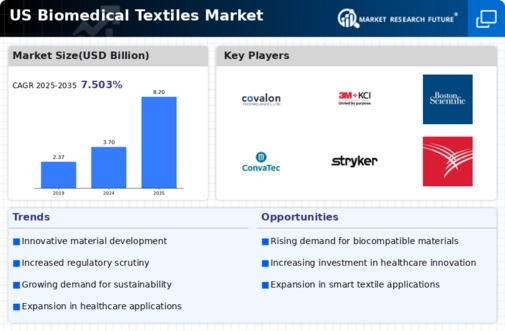The biomedical textiles market is characterized by a dynamic competitive landscape, driven by innovation, technological advancements, and strategic partnerships. Key players such as Medtronic (US), Johnson & Johnson (US), and Boston Scientific (US) are at the forefront, each adopting distinct strategies to enhance their market presence. Medtronic (US) focuses on integrating advanced materials into its product lines, while Johnson & Johnson (US) emphasizes sustainability in its manufacturing processes. Boston Scientific (US) appears to be leveraging digital health technologies to improve patient outcomes, thereby shaping a competitive environment that prioritizes innovation and responsiveness to market needs.
In terms of business tactics, companies are increasingly localizing manufacturing to reduce lead times and enhance supply chain efficiency. The market structure is moderately fragmented, with several players vying for market share. This fragmentation allows for a diverse range of products and innovations, although the collective influence of major companies like 3M (US) and Smith & Nephew (US) is significant in setting industry standards and driving technological advancements.
In November 2025, Medtronic (US) announced a partnership with a leading textile manufacturer to develop bioengineered fabrics aimed at enhancing wound healing. This strategic move is likely to bolster Medtronic's product offerings and position it as a leader in advanced wound care solutions. The collaboration underscores the importance of innovation in product development, particularly in a market that increasingly values efficacy and patient-centric solutions.
In October 2025, Johnson & Johnson (US) launched a new line of biodegradable surgical meshes, reflecting its commitment to sustainability. This initiative not only aligns with global environmental trends but also addresses growing consumer demand for eco-friendly medical products. The introduction of these meshes could potentially reshape market dynamics by setting a new standard for sustainability in biomedical textiles.
In September 2025, Boston Scientific (US) unveiled a digital platform designed to enhance the integration of its biomedical textiles with telehealth services. This platform aims to provide real-time data analytics to healthcare providers, thereby improving patient monitoring and outcomes. The strategic importance of this move lies in its potential to redefine how biomedical textiles are utilized in conjunction with digital health solutions, marking a significant shift towards integrated healthcare delivery.
As of December 2025, current trends in the biomedical textiles market include a pronounced focus on digitalization, sustainability, and the integration of artificial intelligence (AI) into product development. Strategic alliances are increasingly shaping the competitive landscape, enabling companies to pool resources and expertise. Looking ahead, competitive differentiation is likely to evolve from traditional price-based competition to a focus on innovation, technological advancements, and supply chain reliability. This shift suggests that companies that prioritize these elements will be better positioned to thrive in an increasingly complex market.




















Leave a Comment